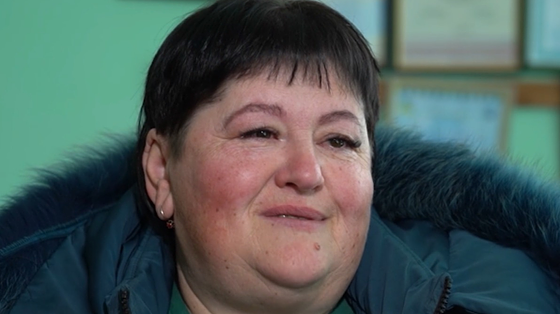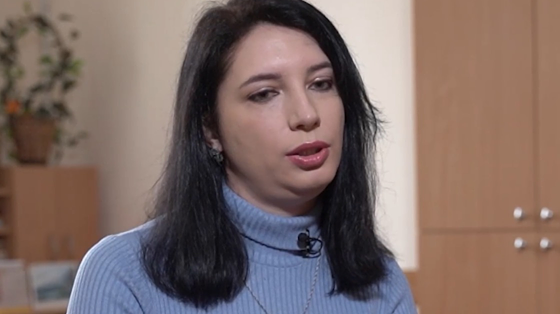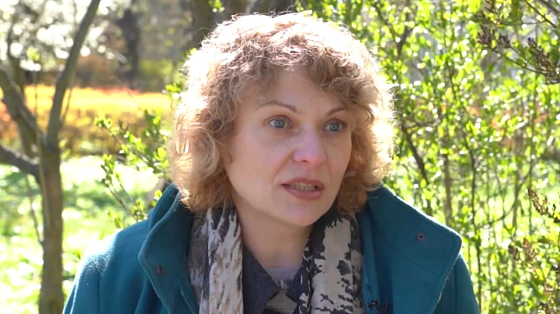Traumatologist Dmytro Pasternak recounts months of his work at municipal hospital no. 3 in Mariupol amid constant bombing attacks and facing the lack of the necessary medicines and equipment.
Despite the unthinkably challenging conditions, he managed to save dozens of lives. A sense of duty and care about wounded civilians made him stay at work until the last.
The 24th of February really changed my whole life. Indeed, the news of the full-scale invasion placed us in certain new conditions, I would say.
From 24 [February] to 5 March, I worked at hospital no. 17. This is the regional hospital located in Mariupol city. The department of traumatology, where I worked, was providing medical aid to wounded residents of Ukraine, both civilians and military, that is soldiers of the Ukrainian Armed Forces. As it was difficult to get to work and the city was under constant shelling, it was decided to provide medical aid to the injured at hospital no. 3, in the cancer department’s building. So, as I lived nearby, literally a 15-minute walk from this building, I agreed to this with great pleasure, since I risked coming under artillery fire when walking to hospital no. 17. That is why on 5 March, I worked in the cancer department of hospital no. 3.
My family was at home on 5 March. My family and my friends, we kept going down at night, when the air raid warning was still announced. We went down to the basement of the five-storey building where my relatives lived, as my building did not have a basement. After I began to work at hospital no. 3, we used the hospital’s bomb shelter. This was a bunker, as we later called it, a large bomb shelter from the Cold War era, built in preparation for a nuclear war outbreak.
There was an air ventilation system and a water supply system there. Interesting thing. Large one... Well, surely, it was built back in the 60s of the last century. Well, in the end it played its role.
When I moved to hospital no. 3 and also moved my family, friends and the family of my friends, on 9 March a bomb attack happened. An iron bomb landed between the cancer department’s buildings. It fell behind the cancer department’s building in the yard, between the children’s clinic and the maternity hospital. There was a huge crater the size of two men...
All the windows were blown out and everything that was on the street was completely destroyed. There were cars and there were some people too. A huge explosion. It was so strong that all the cladding was torn off the buildings. That is, it was an airstrike. If this bomb had hit the building, it would have collapsed like a house of cards. There were women in the maternity hospital who recently delivered or were going to deliver. And there were the wounded there too. They were taken out of there. I can’t say exactly [when] that day the air strikes on the maternity hospital happened. It was in the morning. Airplanes kept bombing constantly. Right from the onset. I don’t know how many attacks on the city happened in total.
My second birthday was on 9 March. I was nearby. Next to the radiology department where there were the so-called guns for treatment, fully charged... X-ray radiation.
If this bomb had hit the radiology department and destroyed it, it would have been a small Chornobyl in the centre of the city.
Few people talk about this. This building of the radiology department is located close by, near the hospital. The building was damaged only partially because it was protected by other buildings. It did not get any heavy strikes, but just some minor damages from mortars and artillery. The part where those radiation guns were located remained intact. Other buildings covered it, so it was not hit, thank God.
After the [air strike on] the theatre, children and adult patients were delivered. They were brought to the children’s surgery department that was still working. I think the strike was on 16 March. Wounded people were delivered to us after a bomb hit there. Wounded children from children’s surgery department were taken to us, to the basement. And there were children who suffered in the strike on the Drama Theatre. But the fact is that the Drama Theatre... after the strike on the Drama Theatre, some people were distributed among different hospitals that could still accept some patients.
After the bombing of the Drama Theatre, patients were coming mostly with blunt injuries, injuries from secondary projectiles, pieces of stones, concrete blocks, and some severe injuries. During this period, people who came for medical help were mostly patients with shrapnel wounds. That is, they were all shrapnel wounds after shellfire, mines, and so on.
There were wounded women and wounded children in bomb shelters.
As medical personnel, we were in the building of hospital no. 3, and then, after 10-11 March, we began to go down and stay for the night in the bomb shelter. Why? Because the artillery shelling was incessant and it was unsafe to be in the building at night. We went upstairs, did our work, and went downstairs to spend the night there. After 12 March, we moved to the bomb shelter completely. Why? Because the cancer department’s building was destroyed by an artillery shell. Then an inter-floor slab collapsed there, one flight of stairs collapsed completely and dressing rooms were fully destroyed. We moved all the equipment and all the medicines that we could take and that we used – surgical instruments, and a lamp.
There was an old, written-off operating table in the bomb shelter. We sort of rejuvenated it, knocked it into shape and used it after that.
We also enclosed a place for the operating room and dressing room in the bunker. We separated a space in the bomb shelter using plastic film, and wired the area for electricity. We had a diesel-fuelled power generator and got the wiring through. While the power generator was in operation, we needed to put bandages within that limited time. While the generator was on, we needed to cook food in time, to heat up tea, charge our phones, and so on.
If it were not for the generator, we would be in a very challenging situation. Initially, there were three doctors in the bomb shelter: myself, a paediatric traumatologist, and an excellent, a superb, very high-class operating room nurse. There were three of us at some stage, almost until the second half of March.
Then some more people joined us in the bomb shelter, those who were left without their housing, left without anything. Roughly speaking, they came with only two bags, women with children – those were two nurses.
One was a procedure room nurse and the other one was also a very professional neurocritical care nurse. Thanks to her, we had the opportunity to anesthetize the wounded in order to perform the operations. So we worked in this mode – we had a fully established operating team and some medical personnel who covered all possible procedures needed for our patients. Notably, we had not only patients from the damaged children’s surgery department, who were taken to us, not only children patients.
They were with their parents, sick children were with their mothers, plus there were a lot of wounded adult patients who stayed with us, who were treated in our bunker. That is, a person who had nowhere to go would come to us. We operated on them and left them in the bunker, since they would need to be further treated, bandaged, and so on. I mean, there were many such cases. There were several such people with injuries. There was even a case that was featured in an interview. It was about Serhiy Vasyliovych. He managed to get to this hospital by some miracle and we operated on him. He stayed with us in the bomb shelter all the time until he left for evacuation.
- Tell me about this patient. What tool did you use to perform the amputation of the left arm?
- We did not have special traumatologist’s tools, so we used some improvised methods. It will take quite a long time to describe, but someday, I hope, I will hang this tool on the wall in a frame.
- I think, yes. But he remembers it with great gratitude, and as I understand…, I don’t know what kind of anaesthesia you gave him, but he told me that he saw almost everything.
- Yes, he saw a little of it at the beginning and at the end. I would say that he saw everything that he had to see, and he did not see what he was not supposed to. If we had not gone for amputation then, he would have simply died of bleeding. It was impossible to save his arm because it was badly damaged up to the forearm.
A married couple, a man and a woman, were admitted to our hospital. They were caught by shellfire while staying in their flat. The Emergency Service’s officers brought them. The woman’s legs were cut. There were injuries of soft tissues with bleeding. We did the primary treatment and stopped the bleeding. And the man had his face, hands, and neck cut. This was a case that we will definitely remember. He had a piece of glass about eight millimetres in size under his eyelid and between the eyelid and the eye. We did not have anaesthesia then, so we had to gently pull it out under the local anaesthesia. We coaxed and persuaded him, and pulled it out carefully.
I am a traumatologist. I’ve never dealt with the eyes before, or anything like that, but cognition comes through comparison, let’s put it this way, and I had to do it all.
Another case that will stay in my memory is also about a man who had multiple gunshot shrapnel wounds on both hands, combined with damages and defects. Two guys, who were his two sons, brought him. They carried him in their arms... without pressure, without anything. First, he was delivered to the emergency medical aid hospital, and then from the emergency medical aid hospital, as he told me, he was released and told, “Go wherever you want.” And so he was delivered to us. A car just drove up, he was taken out and the car left. We realized that the man was simply dying. He was carried inside and put on the operating table, a drip was connected and he was operated on under the local anaesthesia.
We did not have full anaesthesia then. We removed metal fragments and bone fragments, did the primary treatment, and then plastered him.
We did not have an X-ray unit, so we all worked with our fingers. That is, you open the wound, examine it and start the treatment, wash everything well so as not to make it additionally infected. And then you begin to carefully examine the wound with your fingers, feel for this piece of metal with your fingers and with the tools. Why is it important? If there is a foreign metal object, you need to rule out sepsis in the future.
You need to treat the wound well, and you have to do it without an X-ray. We did it manually using whatever was available. Besides, it was in the basement at a temperature of 8-9 degrees Celsius, when you simply open the wound and blood flows out from it, and vapour ascents above it. This is not taught anywhere. It is not shown anywhere. You will not see this in peaceful-life medicine anywhere, never. Then we had a young girl, 19 years old, who came under shellfire on Torgova [Street]. Volunteers brought her wrapped in a carpet, with numerous burns on her body. Multiple small shrapnel wounds, craniocerebral trauma, practically unconscious.
It was almost dark then, and they left her at the door wrapped in a carpet. They said, “Take her.” Well, we took her and did everything we had to do. The girl left on her own feet. Her father was found later, and she came out of the hospital on her own two feet and left with him.
There was one lethal case – a young woman was brought in with a serious injury. First, she was in the surgery department, and then she was taken down to us. She had a severe craniocerebral injury, and without specialized aid, that is, without neurosurgical help, we could not do anything. It’s a heavy feeling, you know. Before the war, let’s say, before this February, I have never dealt with sick and wounded children. But then there were many of them, with all sorts of injuries. It is hard.
To be honest, children behaved very adequately. Some wounded children tried to behave adequately, some were very scared, and some of them squealed. But we soothed them. Their parents were also with them, and we stayed near them too. We tried to create the most positive environment for the children.
Well, we were staying in a closed space, dealing with bandages and operations. Children in a closed space, in one place, I mean, in this bunker. My children were staying right next to me, in the next room, and they heard it. Basically, they caught sight of something and then asked what it was. And you have to explain to the children what, why and how. That is, it was also an emotional stress for the children.
Well, barrage of fire tactics. First comes the shelling from MLRS, that is, Grad MLRS and so on. Then artillery fire, mortars, airstrikes, and then tanks, the advance of some units of the russian army. Massive shelling comes first. That is, everything is levelled with the ground. And then tank units move in further, and so on.
- Do you think we will win, Dima?
- I think, we will.
- Why?
- I hope, I’m sure.
- What will you do when we win? On that particular day.
- I don’t know, something very positive, probably. Well, I’ll call you for sure.
- In conclusion, tell me what would you wish for the residents of our city who are still there?
- To survive, survive because the city has been very badly destroyed.







.png)



